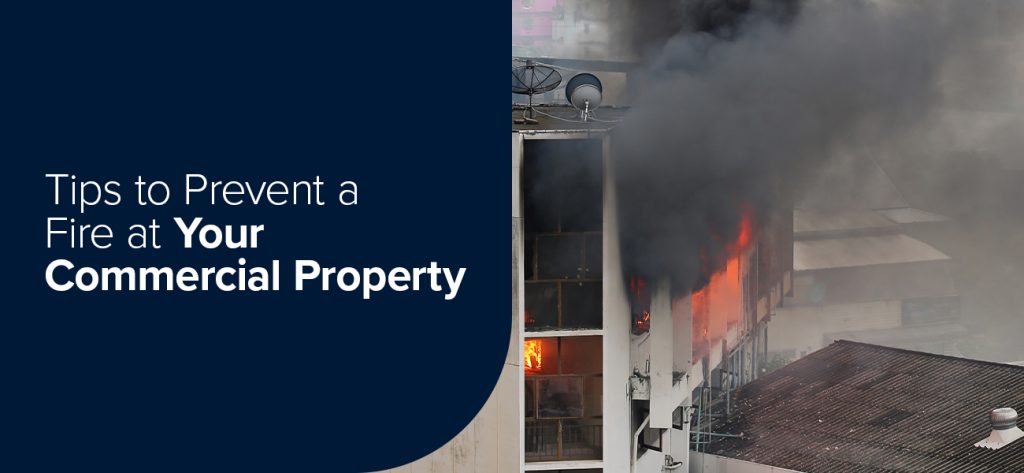
Perhaps your employee has used an extension cord past its life span. Or maybe your building hallways are blocked with packages, boxes or products. While these practices may seem to make life easier or promote workplace efficiency, they may also be hazardous to the safety of your employees and your building itself. Understanding the common causes of fire and prevention methods will make your company safer and remind employees of the best habits.
Some common causes of fire in buildings are linked to unintentional errors or electrical malfunctions. Familiarizing yourself with fire prevention safety tips is critical, especially if you work in an older facility with outdated equipment. This will help to prevent extensive damage to the property and minimize injuries or deaths during a crisis. Here are a few common causes of fires in commercial buildings:
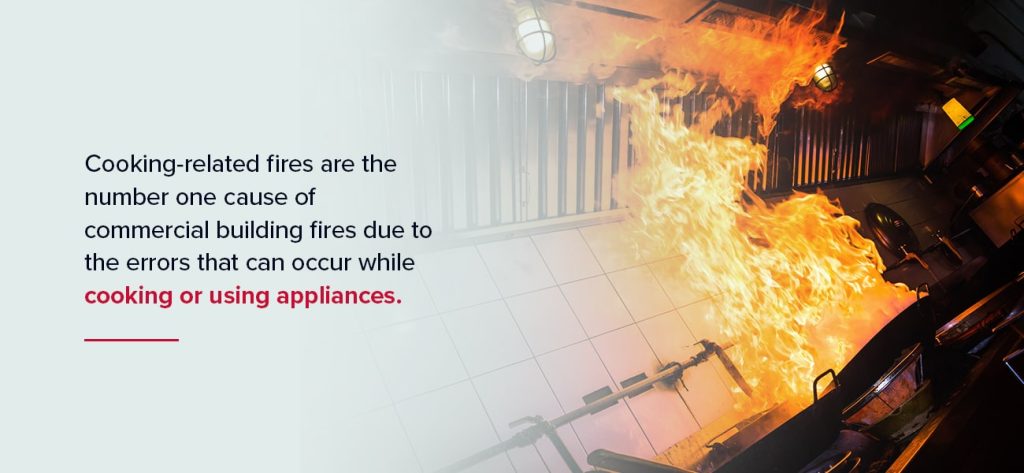
Cooking-related fires are the number one cause of commercial building fires due to the errors that can occur while cooking or using appliances. Certain foods may be more likely to burn if left unattended on the stove, and placing hazardous materials into the microwave could make it short-circuit.
In some cases, appliances like the stovetop, toaster or microwave may break or malfunction, causing sparks or fires. Kitchens can be extremely risky spaces for employees. To ensure the safety of the building, you should place sprinklers, fire extinguishers and smoke alarms in every room or various places throughout the facility, especially near the kitchen.
Intentional fires, or arson, are another common cause of fires in commercial buildings. These fires are perhaps the most dangerous because they can lead to a significant amount of damage and a high number of injuries and deaths. Most intentional fires are started after working hours when employees are not there to catch the culprit or sound an alarm, which often results in more damage.
An arsonist may start a fire in a bathroom, trash can, dumpster or garage. Because the fire’s origin may be unpredictable, installing fire prevention and detection systems in various places is smart. To prevent intentional fires from spreading, ensure that trash cans are emptied daily. Place dumpsters away from buildings to limit the spread, and trim trees and bushes as often as possible.
In some cases, motion detectors or fire curtains can be helpful technologies for catching culprits or preventing crimes from being committed.
Human error is another reason fires may start in commercial buildings. Though some errors may be accidental, there are still many incidents that are entirely preventable. To prevent unintentional fires, train your employees on fire safety in buildings. You should encourage your employees to:
Aside from training your employees on commercial fire safety, you can install alarms and fire curtains that will limit the spread of fire and alert employees of an emergency. You’ll want the entire building to be prepared should a fire happen.
HVACs, central heating systems, water heaters or space heaters may all start fires. To prevent this, have your system regularly inspected during the winter when heating is used the most. Make sure any flammable objects like plastic, wood or fabric are kept away from the heat and install smoke alarms in your heating storage spaces. This will ensure you can catch the fire and address the problem before it spreads.
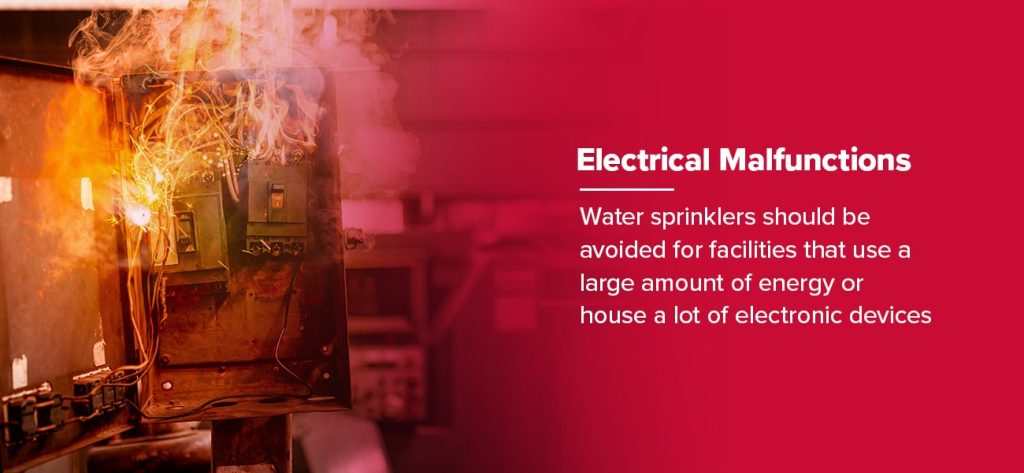
Many fires start when an electrical system malfunctions, often due to faulty wiring. A professional should inspect all buildings to ensure their wiring is up to date and return every few years. Water sprinklers should be avoided for facilities that use a large amount of energy or house a lot of electronic devices. Instead, install chemical foam sprinklers that can defuse the fire in electronic equipment without damaging them.
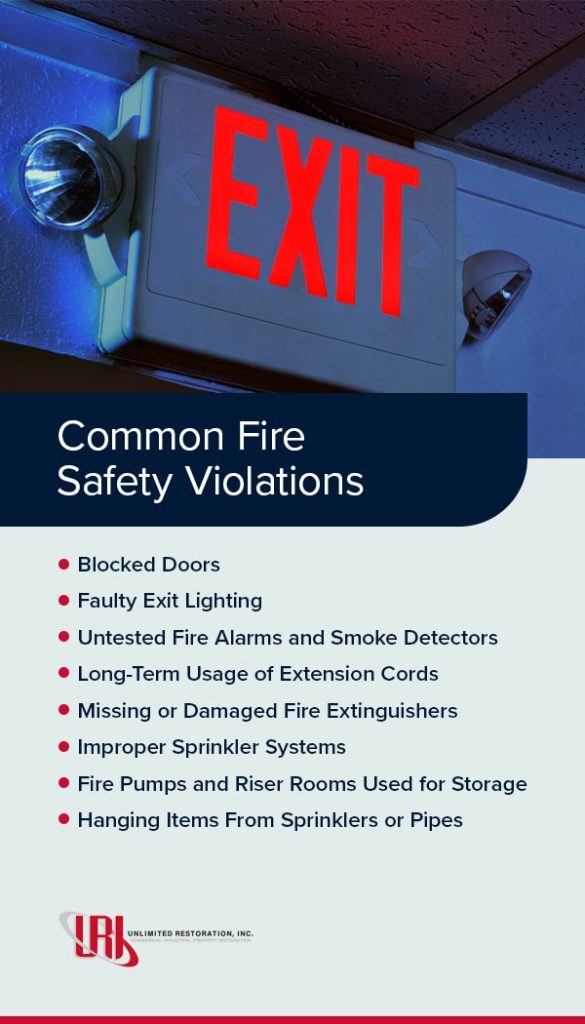
All employees in the building must be aware of the common fire safety violations. Sometimes your employees may not realize that a specific action is a violation and could be hazardous to the building or their fellow employees. Here are a few common violations to look out for:
Blocked doors or hallways may be common in workplaces that are too busy to keep up with their products or storage boxes. However, blocked doors prevent people from exiting a fire during drills or an actual emergency. Sometimes, facilities will temporarily place delivered packages or boxes in front of a doorway without thinking of moving them immediately. This can be a hazardous decision — any blocked aisles, stairs or walkways should be clear at all times to make evacuation easier.
All commercial buildings are required to have working exit signs. To ensure the facility is up to standard, have the exit lights tested and certified annually. Replace batteries annually, as a broken exit light could make it take longer for employees to get out of the building.
If a power outage occurs, the exit lights will need to be able to remain lit for 90 minutes. Even if your employees are familiar with the space, dark areas or smokey conditions can cause disorientation, and exit lights are one of the most critical safety features you can install.
Fire alarms and smoke detectors should be tested every year by a technician. Make sure you don’t forget about these alarms by blocking them with equipment or products. Keeping up with faulty detectors or missing alarms can prevent property damage and improve employee safety.
Alarms are often one of the first lines of defense against fire hazards. They alert employees to danger and allow time for evacuation and contacting emergency services. As such, alarms and detectors should be consistently maintained and tested. Conduct fire drills and make sure your employees know the facility’s evacuation plan.
Many employees may not realize that extension cords are only meant to be used temporarily. Leaving devices plugged into an extension cord for weeks or months could create a fire hazard. Because of this, long-term usage of extension cords is a very common fire code violation.
Make sure your company hires an electrician to professionally install more outlets if your employees need to plug in different devices or appliances. All outlets, panels and junction boxes should also be covered in UL-listed plates, as many fires stem from faulty or worn wires.
A typical fire safety violation is failing to schedule your fire extinguishers for maintenance and inspection. Over time, some extinguishers may become damaged or go missing, and used fire extinguishers will need replacing. Especially in big box stores and warehouses, fire extinguishers should remain charged, inspected and classified.
Without a fire extinguisher for a commercial building, many small fires can spread quickly and cause damage to the property or harm to employees. Putting out fires before they spread can prevent larger fires and provide peace of mind during the work day.
Fire extinguishers should be placed no more than 75 feet apart from each other. Have them inspected monthly and yearly by a trained inspector to ensure they continue working correctly. All employees in the building should be trained on how to use fire extinguishers to ensure they know how to respond during a potential crisis.
Commercial buildings must have sprinkler systems that fit their needs. However, in some cases, the sprinkler system could be mismatched or outdated. If the building has been newly converted from an old space, you’ll need to update the sprinkler system to ensure they respond to a fire.
The sprinkler system can be professionally installed and serviced throughout the year. An outdated system may result in more damage to the property and unsafe conditions for employees, which could lead to injury or death. To ensure your sprinklers work correctly, check the control valves every month and ensure that no items are too close to the sprinkler heads. It may also be a good idea to have the pipes inspected once in a while to ensure the water is connected to the sprinkler system.
While your fire pump or riser room may seem like a good space for extra storage, this can be a dangerous practice. Placing additional items in the room other than the fire protection equipment is a fire safety violation. In the case of a fire, firefighters or emergency responders will need to access the space quickly, and any boxes or products blocking the way will slow them down. Check the room for any packages, mops, brooms or cleaning equipment and clear the area.
Hanging clothing, lights or signs on sprinkler heads is one of the most common fire safety violations. Remember that hanging items from sprinklers can accidentally activate the system, causing water damage to the building. Ensure your employees know that hanging things off exposed sprinkler heads or pipes is hazardous. You can also add warning signs as reminders.
Understanding the standard fire safety violations helps employees establish safe practices in the workplace. It is also essential for them to be familiar with the various ways to prevent fires on commercial properties to limit the chance of damage or injury in the workplace. Safe practices can reduce fire hazards and remind employees of emergency procedures if a crisis occurs.
One of the best ways to prevent fires is by reducing existing fire hazards on the property and eliminating any safety violations in the building. Some common fire hazards include:
Look inside and outside the property to see what fire hazards you can eliminate and ensure your employees are educated about fire prevention and safe practices.
Ensure your equipment, such as fire alarms and sprinkler systems, are well-maintained and regularly inspected. These pieces of equipment will help lessen fire damage and spread. Ensure your sprinkler systems are updated and checked yearly and have fire extinguishers available throughout the property. Talk to your local fire department or emergency services department if you want advice on how to maintain your equipment or what equipment to install.
Every employee in the building should be familiar with the fire safety plan and any other emergency procedures the facility creates. This means understanding escape routes, response plans, their safety point person and accountability measures. The fire safety plan should be reviewed often and updated with current contact and building information. Have the employees or tenants practice the plan during fire drills so that they know what to do in case of an emergency.
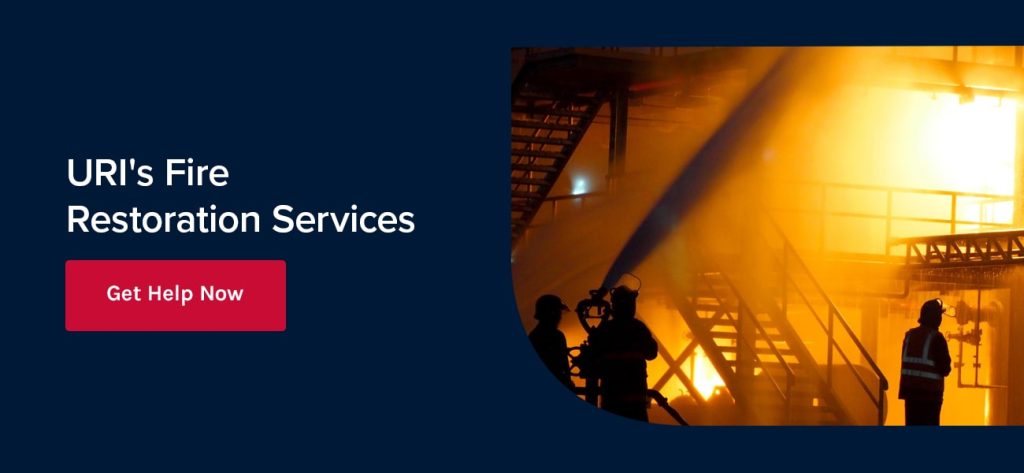
At Unlimited Restoration, we understand that fire can cause extensive damage to your property and that the cost of rebuilding quickly adds up. Without a restoration company by your side, the task of cleaning up the disaster or starting the rebuilding process may seem daunting.
Our company responds quickly to fire damage and comes prepared with expert plans and prepared solutions for rapid emergency restoration. We offer proven fire damage restoration services that will address the damage for you and work to rebuild as soon as possible. Fill out our contact form to speak to a representative, or call 888-327-9664 today.